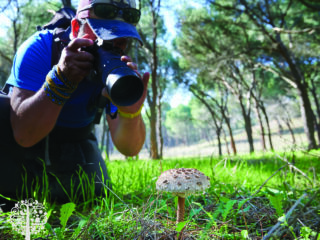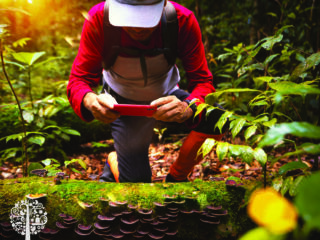When you’re into mycology, there’s a good chance you’re really into mycology. Not everyone who enjoys wild mushrooms becomes obsessed with how they connect widely and wildly with nearly any aspect of our lives. However, for many of us, the fun(gi) never stops.
Positive examples of human relationships with fungi include basic sustenance to gustatory triumph, support and promotion of physical, mental, and emotional well-being, and spiritual or extranormal experiences. You could choose to focus on how the potency of mushrooms allows some to be dangerous in all of the same areas, but a grounded, balanced, and hopeful mindset is more productive. Respect for their potential and humility in our relationships with them can guide us to rich and impactful experiences!
It’s certainly not lost on “mushroom people” that mycelium, as a network of interconnectivity, sharing, and a sense that the sums are more significant than the parts, is a solid metaphor for the power of community. Trust-building through shared experiences is neurochemically rewarding, and organising opportunities for folks to find delight and satisfaction together is a gift you also receive.
If going out into nature to find mushrooms is your cup of tea, or if you’ve got access to land where you cultivate and/or wildcraft mushrooms, why not invite some people to enjoy a day out with you? Here are some tips I’ve put together based on my experiences.
A Beginner-Friendly Approach to Organising and Guiding a Mushroom Walk
Choose an accessible and safe place to meet and be familiar with the conditions of where you’ll walk. Ensure someone knows where you are, who you’re with, and when you’re expected to return.
Decide how you will select your companions for the trip. Are they friends and family? Is it an open, public event or one arranged in collaboration with a community organisation?
If you’re artsy, you might make a poster or other design with the main details: what you’re doing, who’s welcome, when it’ll be happening, where, and why you hope people will join you.
There’s no need to advertise the location specifics publicly; instead, ask people to RSVP to receive the details. It’s best to know how many people you expect to attend and be able to cancel if personal or weather-related reasons for postponement or cancellation arise.
A few common questions I have found people would like answered before they commit include:
- Are there any costs involved (e.g. parking, park entrance fees)
- Are children and/or dogs welcome to attend?
- What should I bring with me?
- How strenuous is the terrain? What is the expected pace, distance, and timeframe for the outing?
In your invitation to participate, be clear about the point and parameters of the excursion. Build trust by being honest about your experience and knowledge about mushrooms. Don’t try to sound authoritative beyond your comfort level; allow your curiosity and passion to shine through.
Before the meeting, request attendees review a drafted community agreement. This agreement can include expectations of mutual respect, recognising that each participant is to be valued and accepted as they are. It can be explicit that each person will come with their own prior experiences with mushrooms and make clear everyone is responsible for keeping the event fun and safe.
This agreement can also be practical, asking party members to take only photographs (or drawings) and memories when they leave. This removes the expectation that the walk will focus on foraging and instead be centred around mushroom appreciation.

On The Day of the Walk
It’s a good idea to wear a high-visibility vest or similarly bright attire and bring a whistle. This way, your walking companions can return to following your lead while their attention is divided between absorbing the natural setting and seeking mushrooms to observe.
At the set meeting time, welcome the group and thank them for coming! It’s already a success if you’re not the only one standing alone in a parking lot. I have found that asking participants to form a circle rather than standing in front of a loose pack is best for making everyone feel included and equal. Review the community agreement and ask folks to reconfirm their intent to have a fun time. It might seem a little juvenile, but proposing a buddy system can be a good check against anyone feeling left out or wandering away.
Ask people to introduce themselves and give a one-sentence summary about their interest in mushrooms. Open the floor to anyone wishing to share concerns they may have about the activity itself. They might disclose accessibility challenges, personal boundaries around space and touch, or well-meaning “help” from others.
Demonstrate, with prior warning, the sound of the whistle.
During the Walk
I always like to scope out the trail before bringing others out with me or use a place I’m very familiar with for beginner-level walks. Coming prepared with a short list of expected species to keep an eye out for is very handy, as is having a few “fun facts” or mushroom-related anecdotes in mind to set the vibe.
Hopefully, folks are stoked to see any kind of mushroom and try to discover more about it. Why do you think it is located where you found it? What’s unique about this mushroom? Are there many, or does it stand alone?
Although people want to learn which mushrooms they can eat, there’s a lot of responsibility in providing definitive answers.
When you don’t know how much detail someone will take and retain from the information you share, it can be better to keep people accountable for their actions. Select locally relevant species identification guides and help folks develop their myco-vocabulary with real-world subjects. If you do find specimens of choice edibles, encourage people to use their senses to observe and become physically familiar with them. Creating that memory for personal reference is valuable in itself.
As you make your way along the chosen route, remember that you have placed yourself in a position of trust and example-setting. Be free with your enthusiasm for mycology, wild mushrooms, and other marvels of nature you’re witnessing. Model care and regard for the conservation of the space.
When the Trip is Over
Offer an email sign-up list or other means of communicating about future fungi experiences (like a hosted server or group) that all will share. Be clear about the level of moderation you’re willing/able to provide, and remind people that they are placing trust in one another not to abuse the disclosure of contact details.
An expression of gratitude for accompanying you on the mushroom walk is always appreciated. This doesn’t have to cost you anything other than your time. It could be as simple as a sincere “Thanks for coming” at the end of the outing, a follow-up email with a photograph from the day and maybe some links to your favourite mushroom-related resources. If you feel really fancy, design a digital participation certificate that people can post to their social media or even print off for their wall at home or scrapbook.

Additional Preparatory Considerations
Keep your ambition proportional to your abilities. Mushrooms are everywhere! There’s no need to venture far into the wilderness to find plenty of fungal life just waiting to be noticed.
It’s good to prepare for the unexpected whenever you’re in nature. If you don’t have any first-aid training, ask a qualified friend to join you. Be clear on how you will handle any medical emergencies that could arise. Are you sure that cell phones will have signals if you need to contact emergency services?
Reflect on the Experience
If you have fun with the group and enjoy your role as organiser, other activities are similarly friendly to all levels of mycological expertise. You could arrange a meet-up for a meal prepared by a qualified cook with safe food handling training using fungi acquired through credible sources. A fungi-focused art-making get-together or topical movie screening are also good options for the ‘indoor cats’ among us. Both are good choices for times of year when it is less opportune to observe wild-growing mushrooms.
Final Thoughts
Rather than trying to masquerade as the ultimate expert in all things myco, invite yourself to develop new wisdom as a consequence of communion with others. Although the concept of “set and setting” may be most familiar in the paradigm of psychedelics, consider that they may also apply to any scenario in which folks may learn about new things and discover how this knowledge transforms them, perhaps even affecting their worldview. Cultivate a setting that supports you and your companions. Maybe you’ll inspire others, and next time, someone else will put out the call!
Trending Products

Ahopegarden Hydroponics Growing Sys...

Ahopegarden Hydroponics Growing Sys...

CYBSDF hydroponic-Growing-Kits-and-...

Hydroponics Growing System Kit 12Po...

Hydroponics Growing System Kit Indo...

BN-LINK 8 Outlet Surge Protector wi...

Light-Blocking Cube Caps Compatible...

SKINNYBUNNY Rockwool Cubes 1 inch, ...

Reusable Plant Support Clips for Ga...

